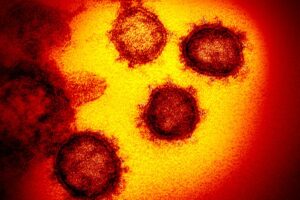As the Delta strain continues to spread, researchers have identified another new strain: the C.1.2 COVID-19 variant. Since May 2021, only about 100 cases of C.1.2 have been reported, primarily in South Africa along with seven other countries in Africa, Asia, and the Pacific, according to CNN.
There’s still much that researchers don’t know about this particular mutation. For example, it’s not yet clear whether the new C.1.2 variant is more dangerous or transmissible than other, more researched COVID-19 strains, or whether it’ll outcompete Delta as the dominant strain.
That said, experts are continuing to learn more about it. Here’s what you need to know about the C.1.2 COVID-19 variant. 
What do researchers know about the C.1.2 COVID-19 variant?
Again, not much is known yet about the C.1.2 variant and how it compares to other variants, like Alpha and Delta. Amesh A. Adalja, MD, a senior scholar at Johns Hopkins Bloomberg School of Public Health’s Center for Health Security tells Health that it was first found in South Africa in July of this year, that it has DNA sequences dating back to May 2021, and that it has some of the same clusters of mutations present in other variations of COVID-19.
However, that the new variant has similar mutations to other variations doesn’t necessarily predict how it will behave (for example, whether it spreads more easily). Kevin McCarthy, PhD, assistant professor of microbiology and molecular genetics at the University of Pittsburgh Center for Vaccine Research, tells Health it’s simply too soon to know these things. “There’s the potential for more transmissibility, but it depends on how all of these mutations play along together,” he says.
There’s also no evidence yet that this strain will cause different or more severe symptoms, according to Dr. Adalja. “It’s premature to say anything other than its demographic and that it has a similar cluster of mutations,” he says, adding that the most important factor in any current or future mutations will be how they change the virus’ function, and how they compare to the Delta strain.
Should we be concerned about the C.1.2 COVID-19 variant?
Dr. Adalja says, so far, there’s no reason to be more concerned about the C.1.2 variant than other variants. It’s not yet listed as a variant of interest, among the several others that have emerged. Something important to understand is that viruses stay alive by mutating, and Dr. Adalja says there are many variants that won’t end up being consequential to the trajectory of the COVID-19 pandemic.
Plus, he says, it’s unlikely C.1.2 will outcompete Delta as the dominant strain. “Viruses compete for hosts to infect, and the Delta variant appears to be the ‘most fit’ version of the virus we’ve seen,” he says. That’s why Delta has completely overtaken the Alpha variant—the initial strain of COVID-19—as the primary strain. “Basically, if you’re being infected [at this point], for all intents and purposes, it’s [likely it’s] the Delta variant.” For any new strain to outcompete Delta, it would have to have a few key traits. Joshua LaBaer, PhD, MD, executive director of the Biodesign Institute at Arizona State University, tells Health there are a few components that cause a mutation to become dominant. The Beta variant—the first mutation of COVID-19 found in South Africa in 2020—was better at evading the immune system than the original strain. He explains that while the Delta variant isn’t necessarily as good at evading the immune system, it’s more powerful at outcompeting other viruses. “If the new mutation has elements of Delta and Beta, that could be an issue,” Dr. LaBaer says. “It could be more evasive and powerful than previous strains.”
The good news is, researchers caught this one early—far earlier than other COVID-19 variants. While previous strains were already widely circulating when scientists began to research them, McCarthy says researchers began characterizing the C.1.2 mutation when there were only 100 recorded cases. “If you can understand something about the virus, you can preempt its spread to a certain point, before it becomes a problem,” he says. “It’s actually a really nice example of the public watching science at its finest.”
The information in this story is accurate as of press time. However, as the situation surrounding COVID-19 continues to evolve, it’s possible that some data have changed since publication. While Health is trying to keep our stories as up-to-date as possible, we also encourage readers to stay informed on news and recommendations for their own communities by using the CDC, WHO, and their local public health department as resources.



